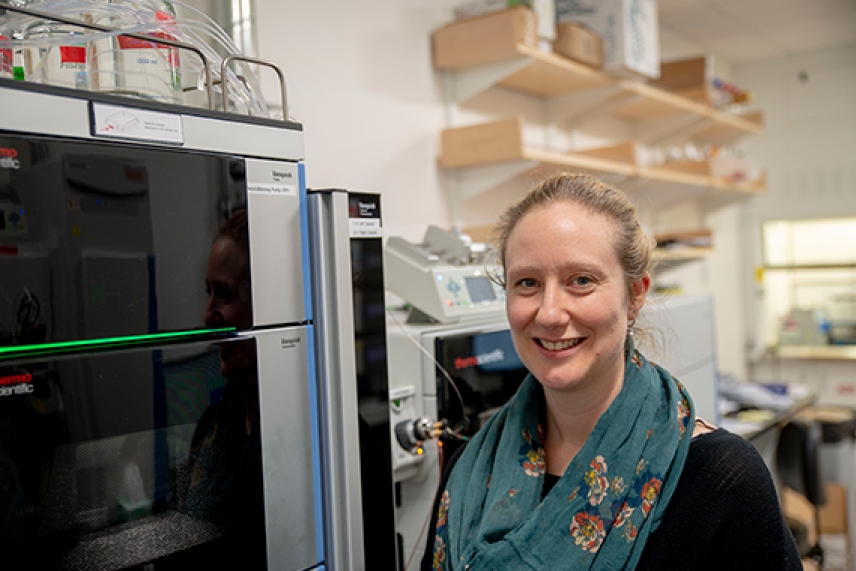
Caroline Lewis
Conor Gearin/Whitehead Institute
Caroline Lewis: Metabolite Profiling Core
Caroline Lewis, director of the Metabolite Profiling Core Facility, is excited about the core’s new instrument. Her team helps Whitehead Institute researchers study chemicals produced in cellular reactions, known as metabolites. These compounds greatly outnumber larger molecules in the cell such as proteins — and many of them have not even been identified.
“In metabolomics, there’s a lot of excitement around untargeted metabolomics,” Lewis says. “The instrument we now have should help with that — it’s been designed specifically for searching for and identifying unknown compounds.”
The device has an impressive name — Orbitrap ID-X Tribrid Mass Spectrometer — but the important thing is that it brings a new layer to the analyses that the core can perform. Lewis explains that once you know the retention time and mass-to-charge ratio of your metabolite, you still might need more information to confirm the identity of the metabolites present. The next step is to fragment the compounds and examine the fragmentation pattern, comparing it to databases.
“What the new instrument does is fragment those fragments,” says Lewis. “It also allows us to collect fragmentation data on very low-abundance species.” The device remembers which 10 compounds it fragmented on the previous step and moves on to the next most abundant 10 compounds. This highly refined procedure lets researchers search for potentially important but less concentrated compounds.
Using liquid chromatography and gas chromatography mass spectrometry (LCMS and GCMS), Lewis and her team help Institute researchers better understand what’s happening in their cells. Even if scientists know an enzyme catalyzes a particular reaction, just measuring the levels of the enzyme itself might not give the full picture, Lewis says. “In fact, metabolic enzymes are often very highly expressed, so expression changes don’t necessarily equal changes in a metabolic reaction,” she says. “The ability to actually measure these metabolites gives you more insight into what’s really going on.”
When a researcher approaches Lewis interested in metabolomics, the first step is talking through the best approach. “They come to us and we have a discussion about what question they really want to answer,” she says. “Then we can think about what would be the best experiment, and which method would help answer that question.”
This process of collaborating and providing guidance is what Lewis enjoys the most about her role. “I enjoy talking to other people about their projects, because I’ve worked on experiments I never would have done, if I had just been running my own research group,” she says. “I’ve worked on zebrafish, the nematode Caenorhabditis elegans (C. elegans), yeast, mouse tissues, tumors, and all kinds of different cell lines. People are doing some really exciting science here, and it’s great to be a part of it.”
Lewis came to Whitehead Institute after her postdoctoral research across the street at the Koch Institute. “I decided that I didn’t necessarily want to be faculty myself, and that actually what I enjoyed most about the postdoc experience was thinking about the science, analyzing data, and interpreting data,” she says.
However, Lewis’s expertise from her research experiences, particularly in stable isotope tracing, have helped her shape the development of the core. “You can use your past knowledge, your PhD and postdoc experiences, to think about what new technology should we bring to Whitehead Institute, and how can we apply this to the members’ research programs,” she says.
Outside of the Institute, Lewis sings in the Park Street Church Choir as an alto, and particularly enjoys singing works by John Rutter or Felix Mendelssohn. She likes being near the ocean in Massachusetts, as she grew up in the United Kingdom, where the water is never more than about two hours away. She enjoys paddle-boarding and kayaking, as well as hiking in the White Mountains of New Hampshire.
Topics
Contact
Communications and Public Affairs
Phone: 617-452-4630
Email: newsroom@wi.mit.edu


